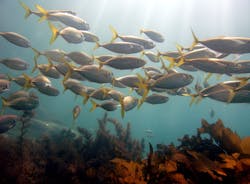CH2M announced it is working with its clients—the Masdar Institute of Science and Technology and the Sustainable Bioenergy Research Consortium (SBRC)—on developing the world's first research facility that uses desert lands irrigated by seawater to produce bioenergy for aviation and raise fish and shrimp for food.
The biofuel research facility is located in Masdar City, Abu Dhabi, United Arab Emirates (UAE), and challenges food and water security while providing a sustainable source of aviation fuel. The facility mimics a coastal environment in an inland location for research purposes.
The system uses seawater to raise fish and shrimp for food. The aquatic life’s nutrient-rich wastewater also fertilizes plants rich in oils that can be harvested for aviation biofuel production. The plants are salt-tolerant halophytes that thrive in arid, desert conditions, such as those in UAE. The wastewater is then diverted into a cultivated mangrove forest, further removing nutrients and providing valuable carbon storage before the naturally filtered and treated effluent is discharged back into the sea.
"Working closely with a team of world-class engineers, researchers from Masdar Institute are exploring a new field of science where the discoveries may have profound impacts on food security, fresh water preservation and the protection of desert and coastline ecosystems,” said Alejandro Ríos, director of SBRC.
CH2M was commissioned last year to undertake the engineering design and construction oversight of the facility. Working closely with the Masdar Institute and SBRC, CH2M engineers translated and defined the concept for the system into a viable operating plant.
"We are very proud to be involved in such an innovative and groundbreaking project," said CH2M's Global Water Business Group President Peter Nicol. "We have drawn on the knowledge and expertise of our global technology leaders in the fields of agri-engineering and science to design the complex elements of this project. We look forward to its successful operation and the scalability of the system being realized."
The goal of the research facility is to demonstrate the viability of an integrated bioenergy production system with respect to essential food and fuel production, suitable land use, reduced carbon emissions, and wastewater cleanup. If the technology proves viable, further expansion will continue with the ultimate ambition to scale to a 200-hectare demonstration site.
Source: CH2M


